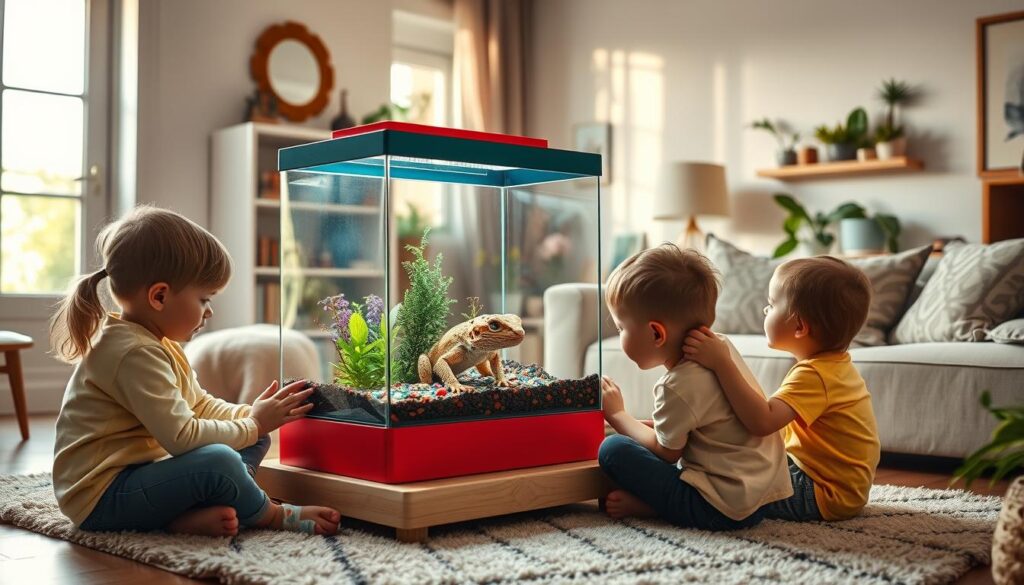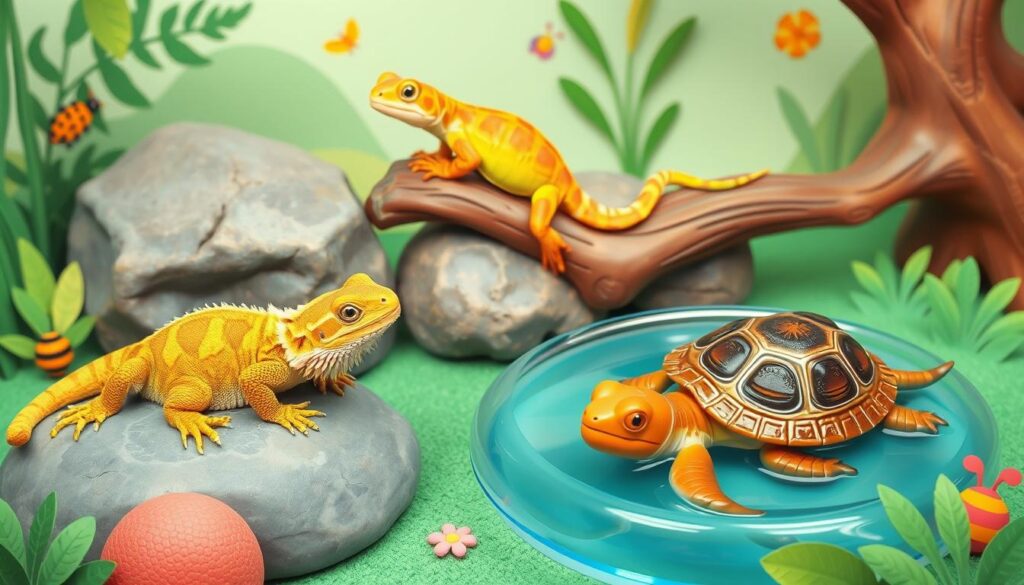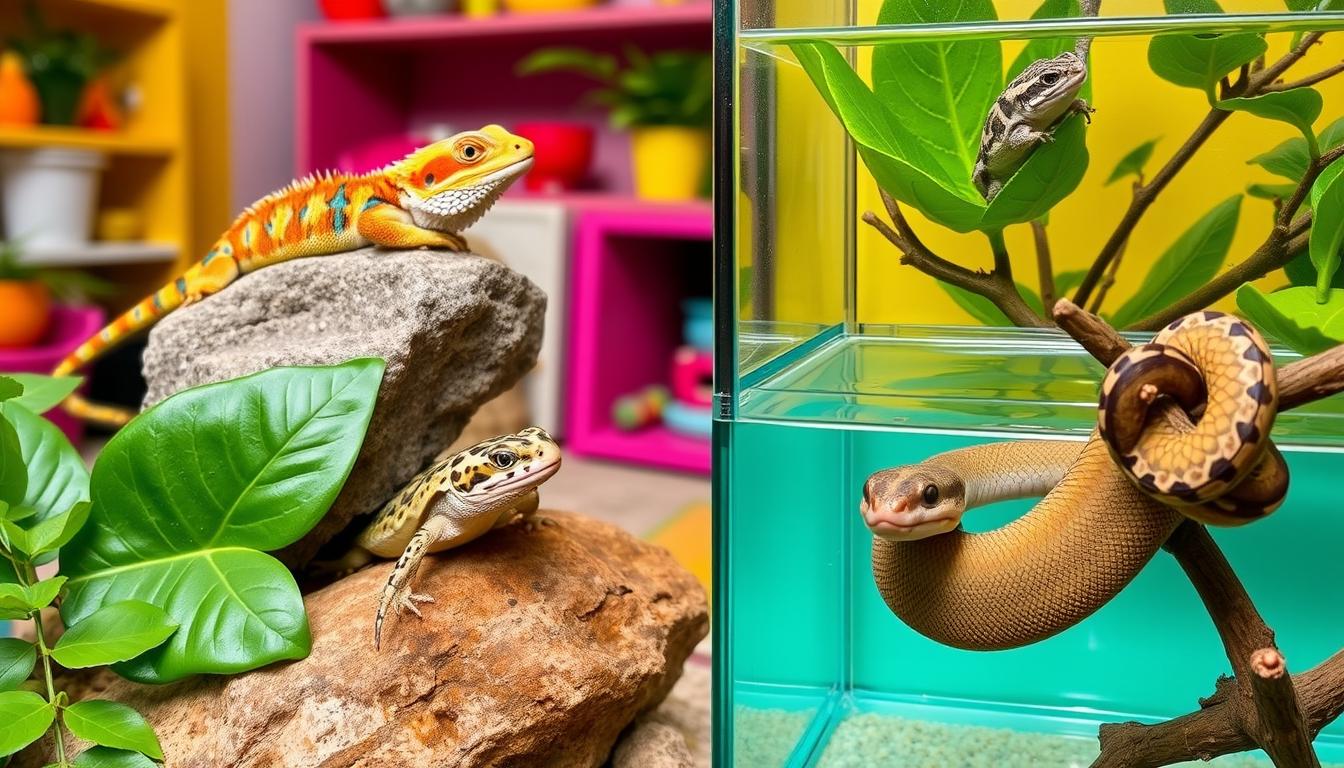Many parents look at turtles, bearded dragons, and geckos as top reptiles for kids. Having a pet teaches kids about responsibility and gives them a friend. Reptiles are great pets for kids because they are easy to care for and fun to watch.
Before getting a reptile, think about safety, space, and care needs. Some reptiles are better for kids than others. Bearded dragons and leopard geckos are popular because they are small, gentle, and easy to care for.
Choosing the right reptile as a pet teaches kids about responsibility and caring for another creature. With the right help, kids can form a strong bond with their pet. This bond brings many benefits, including learning and companionship.
Key Takeaways
- Top reptiles for kids, such as bearded dragons and geckos, make great pets for children.
- Reptiles can teach kids about responsibility and provide companionship.
- It’s essential to consider safety, space, and the level of care required before bringing a reptile into your home.
- Some reptiles are better suited for kids than others, so it’s crucial to choose a gentle and easy-to-handle species.
- The best pet reptiles for children are those that are relatively small, gentle, and easy to care for.
- With the right guidance and supervision, kids can develop a strong bond with their reptile pet.
Why Reptiles Make Excellent Pets for Children
Reptiles can be a great first pet for kids. They offer a chance to learn and grow. With the right kid-friendly reptiles, kids can learn important life skills like responsibility and compassion.
Some popular reptiles for kids are easy to care for. They need little space and care, perfect for families who are busy. This makes them a great choice for kids’ first pets.
Educational Benefits of Reptile Ownership
Having a reptile as a pet can teach kids a lot. They learn about biology, ecosystems, and conservation. It also helps them develop skills like responsibility and time management.
Building Responsibility Through Pet Care
Looking after a reptile means following a routine. This includes feeding, cleaning, and checking on them. It teaches kids to be responsible and empathetic, skills that last a lifetime.
Low-Maintenance Pet Options
Bearded dragons and leopard geckos are great pets for busy families. They need little space and care. This makes them perfect for kids’ first pets.
Safety Considerations for Kid-Friendly Reptiles
When picking easy to care for reptiles for kids, safety is key. It’s important to choose reptiles that are not venomous or aggressive. Bearded dragons and crested geckos are great choices because they are gentle and calm.
To keep reptiles safe, a secure and escape-proof habitat is needed. This means using a strong enclosure and preventing bacteria spread. For more on reptile pet safety, check out reptile pet safety guidelines.
Important safety tips include:
- Always watch children when they handle reptiles
- Teach kids how to handle reptiles correctly
- Keep the environment clean and well-ventilated
By following these tips and picking the right reptiles, parents can ensure a safe space for both kids and reptiles to grow and thrive.
Essential Factors to Consider Before Getting a Reptile Pet
Thinking about getting a reptile pet for your family, especially for kids, is big. You need to think about the space for the reptile’s home, the time you’ll spend caring for it, and the cost. For beginner reptiles for kids, pick ones that are simple to care for and handle.
Some important things to think about include:
- Space needs: Each reptile needs different amounts of space. Make sure you know what your chosen species needs.
- Time commitment: Caring for reptiles is a regular job. This includes feeding, cleaning, and watching their environment.
- Budget: The cost to set up a reptile’s home can be high. You’ll also need to budget for food, vet visits, and new equipment.
For fun reptiles for kids, look at species that are fun to watch and interact with. Bearded dragons and leopard geckos are great examples. With the right care, they can be wonderful pets for kids, teaching them about responsibility and biology.

By thinking about these key points, you can choose wisely. This way, you can give your reptile pet a happy and healthy home.
Top Reptiles for Kids: Best Beginner-Friendly Options
There are many reptiles that are great for kids. They are not only interesting to watch, but they also teach kids about responsibility. Bearded dragons, leopard geckos, and corn snakes are some of the best choices.
These reptiles are easy to care for and handle. They are also gentle, which is perfect for kids starting with reptile care. With the right care, these pets can bring joy and learning to kids for a long time.
These top reptile pets for kids are small, calm, and easy to care for. They are also affordable, which is great for families new to reptiles. Choosing one of these reptiles can give kids a rewarding pet experience that lasts a lifetime.
Bearded Dragons: The Perfect Starter Reptile
Bearded dragons are a favorite among kids who want beginner reptiles for kids. They are friendly and gentle, perfect for kids. With the right care, they can be a fun and educational pet.
There are important things to consider when caring for bearded dragons. You need to provide a good home, a balanced diet, and regular interaction. This helps keep your bearded dragon happy and healthy. For more info on caring for bearded dragons and other fun reptiles for kids, kids can do research.
- Providing a large enough enclosure with proper ventilation and temperature control
- Offering a balanced diet that includes a variety of fruits, vegetables, and protein sources
- Handling and interacting with the bearded dragon regularly to help it become tame and trusting
By following these tips and doing research, kids can ensure their bearded dragon is happy and healthy. This way, they can have a rewarding experience with their fun reptiles for kids.
Leopard Geckos as Family Pets
Leopard geckos are a top choice for kids’ pets. They are small, calm, and easy to care for. They are also gentle and can be handled often, making them perfect for kids.
Leopard geckos are active at night. This means they sleep during the day and play at night. This is great for families who like to spend time with their pets in the evening.
Having leopard geckos as pets has many benefits. They require little care, don’t need much space, and are quiet. They also live a long time, up to 20 years, making them great friends for kids.
Leopard geckos eat live insects like crickets and mealworms. They are easy to feed and need a varied diet to stay healthy.

Leopard geckos are excellent pets for families with kids. They are fun, educational, and easy to care for. With the right care, they can bring joy and learning to the whole family.
Blue-Tongued Skinks: Gentle Giants for Young Handlers
Blue-tongued skinks are a unique and gentle pet option for kids. They are known for their calm demeanor. This makes them great for kids who want a more interactive experience.
When caring for blue-tongued skinks, there are several key factors to consider. You need to provide a suitable enclosure with good ventilation. Also, a heat source and a UVB light are necessary. A balanced diet that includes vegetables, fruits, and protein is also essential.
Care Requirements
- Provide a large enough enclosure with adequate ventilation
- Offer a balanced diet that includes a variety of vegetables, fruits, and protein sources
- Include a heat source and a UVB light
Interaction Guidelines
To ensure a safe and enjoyable interaction with blue-tongued skinks, kids should be taught how to handle them gently. This includes supporting the skink’s body and not picking them up by their tail.
By following these care requirements and interaction guidelines, kids can enjoy a fun and educational experience with blue-tongued skinks. This makes them an excellent choice for beginner reptiles for kids.
Creating the Ideal Reptile Habitat at Home
Keeping easy to care for reptiles for kids requires a good habitat. Bearded dragons, leopard geckos, and blue-tongued skinks are great choices. To make a perfect home, think about temperature, lighting, and what to use on the floor.
A good home for reptiles looks like their natural place. It needs the right temperature for their health. Most reptiles like it between 75°F to 90°F. They also need light to stay healthy and strong.
Temperature Control Essentials
Use heat lamps, mats, or ceramic heaters to control the temperature. Always check the temperature with a thermometer. This makes sure it’s right for your pet.
Lighting Requirements
Lighting needs change with each reptile. But most need 10-12 hours of light and 12-14 hours of dark. A good UVB light is key for their health.
Substrate Choices
The floor should be safe and easy to clean. Reptile carpet, paper towels, and indoor/outdoor carpet are good choices. Stay away from sand, wood shavings, and calcium sand because they can harm your pet.
By thinking about these things, kids can have fun with easy to care for reptiles for kids. They learn about taking care of pets. With the right home, top reptile pets for kids can be happy and teach the family something new.
Daily Care Routines for Kid-Friendly Reptiles
Creating a daily care routine is key for the well-being of reptiles suitable for children. It’s simple and teaches kids about pet care. For beginner reptiles for kids, like bearded dragons or leopard geckos, tasks include feeding, cleaning, and watching their health.
A daily care routine includes:
- Feeding: give a balanced diet, like live insects or commercial pellets
- Cleaning: take out feces and uneaten food, and clean the water and food bowls
- Monitoring: check the temperature, humidity, and lighting to make sure they’re right
By sticking to this routine, kids can keep their reptiles suitable for children happy and healthy. Also, remember to take them for regular vet visits to make sure they’re doing well.
Health Monitoring and Common Issues
Keeping an eye on your reptile’s health is key, especially if they’re pets for kids. Bearded dragons and leopard geckos, for example, need regular vet visits. This helps them stay healthy and happy.
It’s important to know when your reptile is feeling well. A healthy reptile eats well, moves around, and has clear eyes and skin. If you notice any changes, like a drop in appetite or unusual behavior, see a vet right away.
Signs of a Healthy Reptile
- Good appetite and digestion
- Active and alert behavior
- Clear eyes and skin
- Normal stool and urine output
When to Visit a Veterinarian
If your reptile acts differently or shows signs of illness, like being very tired or not eating, take them to the vet. A vet who knows about reptiles can catch problems early. This keeps your reptile pets in top shape.
Teaching Children Proper Reptile Handling
Teaching kids how to handle reptiles safely is key. This is crucial for beginner reptiles for kids. It builds trust and makes sure both the child and reptile have a good time. Reptiles like bearded dragons and leopard geckos are gentle and easy to handle, but need care.
Before kids can handle reptiles, they need to learn the basics. This includes how to hold the reptile right and avoid touching sensitive spots. They can learn this with step-by-step instructions and by practicing.
Basic Handling Techniques
- Wash hands before and after handling reptiles
- Support the reptile’s body, avoiding sensitive areas
- Handle reptiles gently, avoiding sudden movements
Safety Rules and Guidelines
Setting safety rules for kids handling reptiles is vital. This means watching them closely, making sure the reptile’s home is safe, and keeping both the child and reptile comfortable.
By teaching kids how to handle reptiles safely, parents can give them a great learning experience. This experience can help kids love and respect reptiles. It also teaches them important life skills like responsibility and compassion.
Building a Bond: Interaction Tips for Kids and Reptiles
It’s important to help kids and their reptile pets get along well. This makes the experience fun and rewarding. By teaching kids to observe, handle gently, and create a fun environment, they learn to appreciate their top reptile pets for kids.
Here are some fun ways to get kids involved:
- Creating a reptile-friendly habitat with plants, rocks, and water features
- Feeding and caring for the reptiles together
- Observing and learning about the reptiles’ behavior and body language
These activities help kids form a strong bond with their 
Creating a bond with reptiles takes time and effort. But with the right approach, kids can grow to love these amazing creatures for life.
Cost and Long-Term Commitment Overview
Owning a reptile as a pet is a big deal. It takes time and money. If you’re thinking about easy to care for reptiles for kids, know the costs and time needed.
Initial setup, food, and vet visits are big expenses. The first setup can cost $100 to $500. Food costs about $20 to $50 monthly. Vet visits can be $50 to $100 for the first check-up and shots.
Time-wise, beginner reptiles for kids need daily care. This includes feeding, cleaning, and checking their health. It takes 30 minutes to an hour each day, depending on the reptile’s needs.
- Initial setup: $100 to $500
- Food: $20 to $50 per month
- Veterinary care: $50 to $100 per visit
- Daily care and maintenance: 30 minutes to 1 hour per day
Knowing the costs and time needed helps parents decide if a reptile is right for their family.
Embracing the Journey of Reptile Pet Ownership
Starting your journey with a reptile pet is exciting. It’s about the bond and lessons you share. These reptiles are more than pets; they teach kids about responsibility and nature.
With proper care, your reptile will do well. This opens doors to learning and fun. Enjoy the journey, celebrate small wins, and make it a special part of your family’s history. This bond will create lasting memories and a love for reptiles that lasts a lifetime.
FAQ
What are the benefits of keeping a reptile as a pet for kids?
Reptiles offer many benefits for kids. They can teach about biology, ecosystems, and pet care. They also help kids learn responsibility and empathy.
What are some important safety considerations when choosing a reptile for a child?
Choosing a safe reptile is key. Pick one that’s not venomous or aggressive. Make sure the habitat is secure and escape-proof for everyone’s safety.
How much time and space do I need to care for a reptile pet?
The needs vary by reptile species. Some, like bearded dragons, need less space and care. But, bigger reptiles require more room and time.
What are some of the top reptile pets that are kid-friendly?
Bearded dragons, leopard geckos, and blue-tongued skinks are great for kids. They’re gentle, easy to care for, and fun to watch.
How do I properly handle and interact with a reptile pet?
Handling reptiles safely is important. Support their body, move slowly, and watch closely. Teach kids to handle them gently and with respect.
How do I create the ideal habitat for a reptile pet?
Creating a good habitat means thinking about temperature, lighting, and substrate. Use the right heat, light, and substrate for your reptile’s health.
What are the common health issues I should watch out for in a reptile pet?
Keep an eye on your reptile’s health. Watch for signs of illness and seek vet help quickly. Common issues include infections and metabolic problems.
How can I encourage a strong bond between my child and their reptile pet?
Encourage gentle interaction and a stimulating environment. Activities like watching and handling can strengthen their bond. It helps if the reptile can show natural behaviors.

